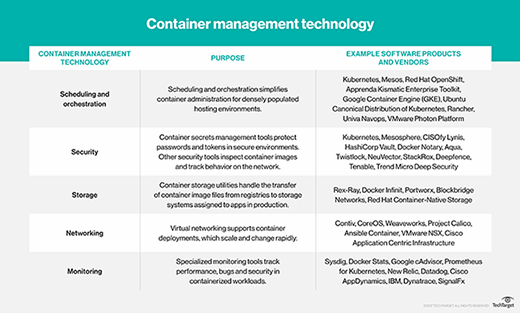
James Thew - Fotolia
Four ways the container ecosystem will evolve in 2018
The container market constantly evolves, as new technologies and uses emerge. See what the new year will bring with these four container predictions around IoT, Windows and more.
Docker containers are barely five years old, but in that time, the container ecosystem has evolved enormously -- and that evolution isn't over yet.
Here's a look at the key trends that are likely to shape the container market in 2018.
Kubernetes becomes default orchestrator
There are a number of container orchestrators available to manage containers, such as Apache Mesos, Docker Swarm and Kubernetes.
For most of Docker's history, none of these orchestrators was a clear favorite. Docker Swarm was attractive because it was developed by Docker itself, while Apache Mesos offered a more mature orchestrator that was not limited to Docker containers.
Kubernetes, which originated from an internal project at Google, was preferred by users who wanted the massive scalability offered by Kubernetes' predecessor, Borg. Now, heading into 2018, it seems that Kubernetes is the orchestration tool of choice.
Recently, Microsoft unveiled a major endorsement of Kubernetes, expanding support for the technology on Azure, and soon after, Amazon Web Services made a similar move on its platform.

Containers in IoT grow
More uses for containers in internet of things (IoT) devices continue to emerge, and that trend will likely grow in 2018.
Because containers deliver software inside portable packages that are easy to deploy, they are an ideal means to install and update applications that run on IoT devices -- especially those with minimal processing power.
However, there are few real-world examples of how containers can play a role in IoT devices, even though IBM has pushed the idea and platforms like resinOS cater to this unique need. Most of the momentum in the Docker container ecosystem so far has centered around servers.
But as companies look for better ways to manage IoT software -- and as IoT adoption continues to grow -- containers are poised to form an important part of the stack.
Windows container use rises
Docker has supported Windows natively since 2016, and there are clear benefits to using those technologies together. Docker, for example, can simplify Windows server management and enable Windows-based microservices deployments in the same way containers do on Linux.
According to Portworx's Annual Container Adoption Survey, the use of Windows containers significantly increased in 2017. The survey found that 29% of respondents used containers on Windows, up from 9% in 2016. Still, there is clearly room for further growth, and it's a safe bet that the container ecosystem on Windows will evolve in 2018.
Developers embrace LinuxKit
Traditionally, one big drawback of Docker containers is that, when developers create them to run on one OS family, such as Linux, they are not compatible with another OS family, like Windows.
LinuxKit, released in the spring of 2017, seeks to ease these portability challenges. Developers can use it to create a containerized application that runs on any Docker-supported platform. The application itself needs to be compatible with Linux, but it can run on a Windows server without any container modifications.
The tool enables developers to achieve Docker's promise of applications that you can build once and run anywhere.
So far, however, there is little evidence that organizations use LinuxKit in a significant way, but expect increased adoption in 2018 to be another trend that propels the container ecosystem.







